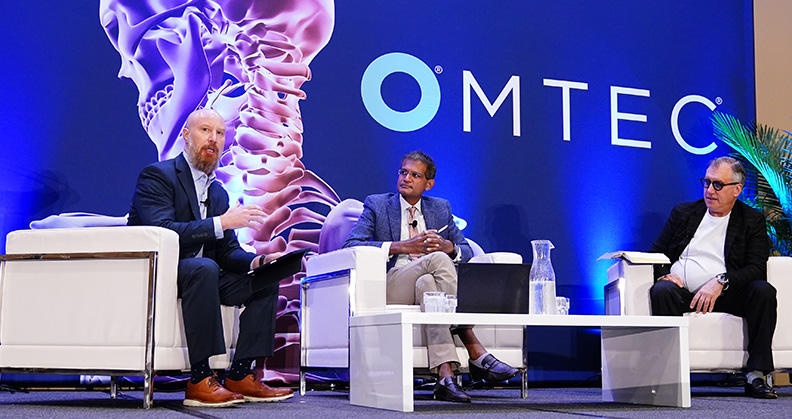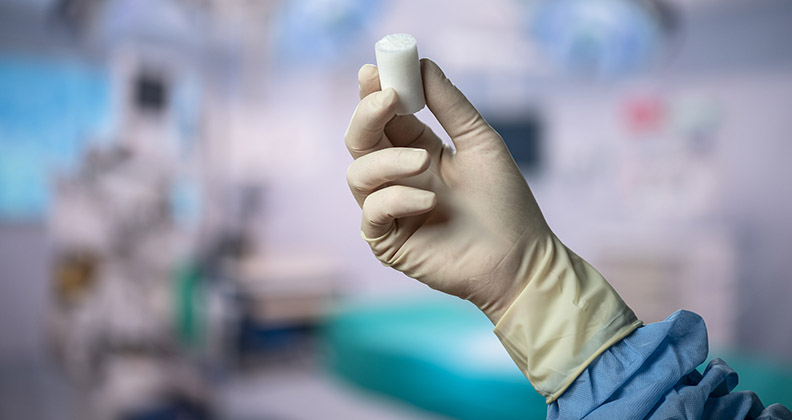
In June, more than 1,600 OEM decision-makers, exhibiting contract suppliers and education presenters converged in Chicago for OMTEC® 2024 to explore the latest developments in orthopedic device advancements, emerging technologies and the market trends that will shape the industry’s future.
During the conference’s keynote panel discussion, ORTHOWORLD’s Senior Market Analyst Mike Evers moderated a wide-ranging and captivating conversation with Ira Kirschenbaum, M.D., Chair of Orthopaedic Surgery at BronxCare Health System and Sharat Kusuma, M.D., President of JointMedica.
The group first addressed the classic equation of value-based care — quality outcomes divided by cost — and explored whether it still applied to today’s orthopedic landscape.
“The big failure in the value equation is that there’s no accounting for revenue,” Dr. Kirschenbaum said. “We cannot cost cut to prosperity in health systems or orthopedic companies.”
They also touched on the consolidation that is taking place across the industry and its impact on device advancements that could improve patient outcomes. Dr. Kirschenbaum noted that acquiring companies and health systems must profit from the purchases they make and often hesitate to invest dollars into the inherent risk of advancing patient care.
“Medtech consists of large companies, health systems and payers that are using their size to increase their selling power,” Dr. Kusuma added. “Those forces are stifling innovation, which unfortunately is becoming a secondary goal throughout the industry.”
Some surgeons have stepped away from the massive consolidation taking place throughout healthcare to run small private practices and independent ASCs that are highly efficient and profitable, Dr. Kusuma noted.
“That presents an opportunity for orthopedic companies to partner directly with these surgeons,” he said. “They’re extremely cost-conscious, particularly regarding implant pricing and case costs. There’s disruptive innovation to be had by partnering directly with entrepreneurial surgeons who are doing the work.”
Dr. Kusuma believes orthopedic companies should capitalize on the significant opportunities presented by the need to improve ways episodes of care are managed, especially as more complex cases such as joint replacements move to the outpatient setting.
“It seems archaic to me that surgeons need to bring patients into the clinic six weeks after procedures simply to check on how their recoveries are progressing,” he said. “That approach feels very outdated. I’ve always believed we could do a much better job of using technology to reduce the post-op management burden for surgeons and their patients.”
He’s passionate about the continued development of smart technology that monitors patients’ recoveries, provides surgeons with real-time data that informs recovery plans and alerts them to potential issues that need to be addressed to improve outcomes.
Dr. Kirschenbaum coined the phrase “patient sourced outcomes” to describe the patient data that is captured from enabling technologies and believes applications of those platforms will explode over the next five to 10 years.
American surgeons are expected to perform 2 million joint replacements next year, according to Dr. Kusuma, who acknowledged the difference in skill sets between high- and low-volume surgeons.
“It’s crucial to enhance how joint replacements are performed, especially for the average surgeon who does 20 to 40 joints a year,” he said. “There is a huge opportunity to integrate accessible navigation and robotic platforms for every surgeon to ensure that outcomes are reliable and reproducible.”
Dr. Kusuma’s experience in developing clinical applications for consumer electronics at Apple taught him about the importance of designing technology with the user experience in mind. He said current robotic guidance platforms aren’t yet intuitive, a factor he believes is limiting their adoption.
“Designing a robot that’s as easy to use as an iPhone or Apple Watch represents a huge opportunity in orthopedics,” he said.
Watch the Keynote
Drs. Kirschenbaum and Kusuma touched on the importance of including surgeons in the design of future orthopedic implants and enabling technologies.
“Decisions are often made without enough input from those who use the products,” Dr. Kirschenbaum said. “Over the years, this has been a significant issue. It’s important to have user experience incorporated into the design process.”
He noted that surgeon key opinion leaders must embody the company’s mission and provide deeper feedback than one-hour prototyping consultants.
Simply placing digital solutions in operating rooms doesn’t make an orthopedic company a service provider, Dr. Kusuma noted. “Engineers and product managers should spend time with surgeons to see how they work and operate and design solutions that meet their specific clinical needs.”
Dr. Kirschenbaum agreed with Dr. Kusuma and provided the company reps who attended the keynote with invaluable advice.
“You cannot be a service provider if you’re not addressing the actual pain points of your surgeon users,” he said. “If you’re not solving the specific issues that surgeons face, you’re not truly providing a service. You’re offering a service that you think is needed.”
Editor’s Note: Read more about professional development and regulatory challenges discussed at OMTEC 2024.
DC
Dan Cook is a Senior Editor at ORTHOWORLD. He develops content focused on important industry trends, top thought leaders and innovative technologies.




